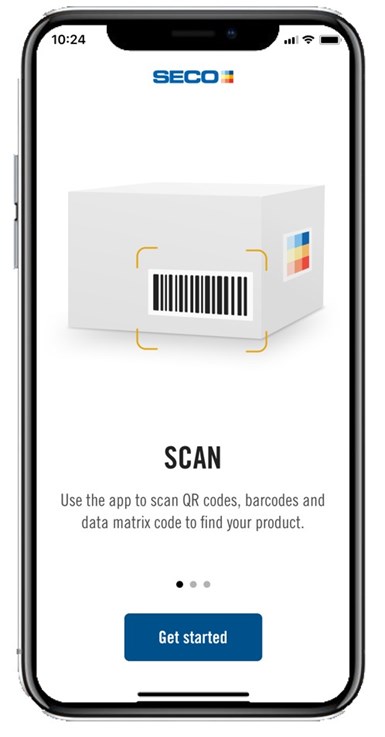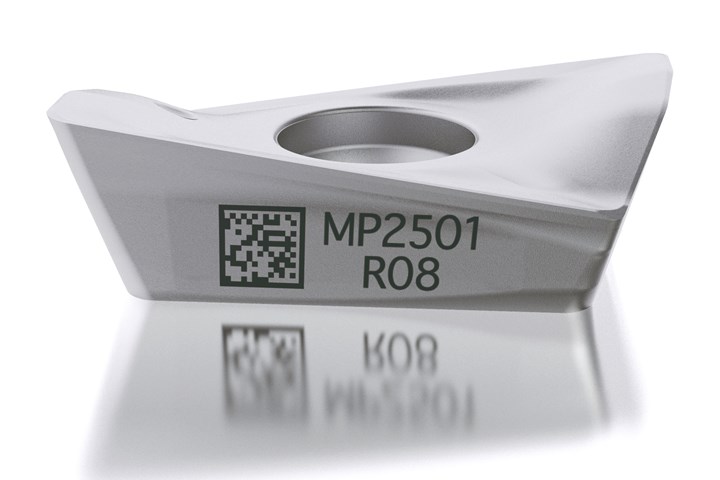Data Matrix Codes Offer Cutting Tool Traceability
Appears in Print as: 'Cracking the Code to Tool Traceability'
A company’s quest to discover errors in a manufacturing process has led to printing data matrix codes on its cutting tools that provide a wealth of information for both the user and this cutting tool manufacturer.
#techbrief
Edited by Lori Beckman
Product traceability is an important issue for many industries. The task recently has become easier with the introduction of scannable codes on cutting tools that provide critical information about the tool and tracks the tool throughout its life cycle.
Seco Tools began laser marking data matrix identification codes on its Turbo 16 square shoulder cutting tool family in 2021. The cutting tools in this series are almost identical to the eye, which is how the company realized the potential value of these codes for users.
Featured Content
The data matrix symbols resemble small QR codes with black and white cells arranged in a square or rectangular pattern. They can encode a 50-digit number in a symbol that is reliably readable to as small as 4 mm2. The small size of the codes means the company can laser print them on smaller tools like inserts or on the back surfaces of larger round tools rather than on the shank.
The data matrix symbols laser printed on some Seco Tools’ inserts resemble small QR codes with black and white cells arranged in a square or rectangular pattern. Photo Credit: Seco Tools
By scanning the code with the Seco Assistant app, users can quickly and easily identify which Turbo 16 insert they are holding and learn more about the tool.
“Ideally, users will input data about how they use the tool into the system — what machine they use, when it is installed, how long it is used for and for what purpose,” says Micael Baudin, specialist in digitalization at Seco Tools. “Scanning the codes on the tool then brings up all that data, which basically is the life story of the tool.”
Knowing the identity of the tool is only the beginning of learning the benefits of data matrix codes on tools. Paperless instructions, data collection, waste prevention, more efficient recycling and reconditioning as well as easy access to tool measurements are only some of the many advantages to using these codes.
Decoding History
Although data matrix codes have not yet been widely adopted by the machine tool industry, these codes are not new. The U.S. Department of Defense has required them on much of its equipment since 2005, and the technology is well established in the automotive, aerospace, medical equipment, computer, food, and logistics industries, according to Seco Tools.
The idea for matrix codes on this manufacturer’s products was sparked in 2018. That was when Jan Gravningsbråten, an R&D technician at the company’s Innovation Lab in Fagersta, Sweden, noticed that when errors occurred in the production process, it was impossible to identify the individual tools that were affected because each tool was only characterized by a batch number.

Anyone on the shop floor can use the Seco Assistant app to quickly access the necessary gathered information. Also, by scanning codes on the app, paperless instructions for tool use and installation are available. Therefore, losing paper manuals is no longer an excuse for improper application. Photo Credit: Seco Tools
“You could have 10,000 or 20,000 in a batch, and it was impossible to work out which ones might have been affected by a production fault, so we would have to start all over again,” Gravningsbråten says. “That’s not really economically viable.”
He then chose a series of 10 billion numbers for the codes, which can be fully traced into each tool marked with them using software that collects all the codes from the machines that produce the tools.
Seco Tools prints the code early in the cutting tool manufacturing process, measuring the exact individual dimensions of each tool. It then adds that information to a database linked to that individual code.
Scanning for Benefits
According to Seco Tools, there are many advantages to identifying tools by scanning the data matrix code.
First, the codes prevent the waste of expensive material by increasing the likelihood that operators are using the right insert or round tool for an application and that machines are calibrated correctly. Anyone on the shop floor can use the Seco Assistant app to access the necessary information in a matter of seconds, the company says.
Also, by scanning codes on the app, paperless instructions for tool use and installation are available. Therefore, losing paper manuals is no longer an excuse for improper application.
Because data matrix codes identify each product with its own code and number, it opens up possibilities for tool traceability, data collection, and reconditioning and recycling across all phases of a tool’s life cycle.
The company’s accurate data collection for each cutting tool enables more automation as well. Customers whose processes are too precise to tolerate small variations in size will no longer need to minutely measure inserts manually. It also enables tool calibration to be done automatically by any machine that can read the codes.
As Seco Tools continues to add data matrix codes to its cutting tool families, users are becoming more equipped for the latest technology including Industry 4.0, automation and sensor technology.
Similarly, when tools are returned for sharpening or reconditioning, the customer can access the tool’s new dimensions through the code and then calibrate machines manually or automatically without having to measure the tool again.
Along with these advantages of the data matrix code, traceability is another boon. The ability to track tools is becoming increasingly crucial within the automotive, aerospace and medical sectors. It prevents the need to recall entire tool batches when the fault is with only one individual unit. It also helps to determine legal liability.
For Recycling and Usability Data
The data matrix codes can also benefit Seco Tools and the users in their recycling efforts. When cutting tools are worn out, most of the material remains intact, leaving significant potential for recycling. Data matrix codes provide an automatic record of how many units are returned for recycling with the company’s buy-back program.
Also, with the ability to scan worn out tools, the company’s recycling facilities can learn about their exact material composition.
Tracking each individual unit also provides the cutting tool manufacturer with data on how long tools sat on users’ shelves, how often they are installed on a machine per day or per month, and how they perform on different machines. This data permits the company to predict orders and tailor production to users’ needs.
As Seco Tools continues to add data matrix codes to its cutting tool families, which opens access to the data attached to them, cutting tool users are becoming more equipped for the latest technology, including Industry 4.0, automation and sensor technology.
RELATED CONTENT
-
PMTS 2023 Product Preview: Cutting Tools
Learn about some of the latest cutting tool solutions that will be on display at PMTS 2023.
-
Vision Metrology for Medical
Understanding best practices and the options available with vision measurement systems is particularly important when inspecting complex medical components having stringent traceability requirements.
-
Precision Machining Technology Review September 2022: Cutting Tools
Production Machining showcases some of the latest cutting tools, including technology from Heule Precision Tools, Horn, Ceratizit, Ingersoll Cutting Tools, Schwanog and Walter.







